Inside the Gender Wage Gap, Part II: Earnings of Latinas in New York City
Economic Status of Latinas in New York City
Equal Pay Day, commemorated on April 10th this year, marks the symbolic day that women’s earnings catch up to what men made during the previous year. However, this date, derived from comparing the median earnings of all full-time working women and men, obscures that women are not all equally disadvantaged when it comes to pay inequality. In fact, a closer look at the data by race and ethnicity reveals that nearly all women of color face larger disparities in earnings and therefore have to work longer into the year to make what white, non-Hispanic men are paid in a single year. In 2018, for example, Black women do not reach symbolic parity until August 7th, and Latina Equal Pay Day is not observed until November 1st – ten months into the calendar.
Equal pay for equal work is a concept as old as labor organizing and remains elusive today, more so for women of color. While the Equal Pay Act of 1963 officially prohibited gender-based wage discrimination, it was not until the passage of the Civil Rights Act the following year that race became a protected class. That women of color experience discrimination at work on the basis of both sex and race—and that it is precisely the intersection of marginalized identities that compounds economic disparities—has long been sidelined in prevailing conversations about equal pay, especially at the national level.
New York City Comptroller Scott M. Stringer’s April 2018 report Power and the Gender Wage Gap: How Pay Disparities Differ by Race and Occupation in New York City showed that while women make less on average than men in New York City, the gender wage gap is significantly larger for women of color.[1] In this policy brief, the second in a series on the economic experiences of women of color, the Comptroller’s Office further analyzes U.S. Census Bureau earnings data to examine the scale and impact of the gender wage gap specifically for Latinas in New York City.[2] Findings detailed in this brief include:
- Latinas experience the largest wage gap among women of color. In 2016, Latinas working full-time in New York City made 49 cents for every dollar paid to white men—roughly $38,000 less on average.
- The wage gap for Latinas in New York City (51 cents) is larger than for Latinas in New York (44 cents) and Latinas in the U.S. (46 cents). If New York City were to observe its own local Latina Equal Pay Day, it would not be until January 16th, 2019.
- Over a 40-year career, the median full-time working Latina in New York City would lose on average $1.5 million in earnings due to the gender wage gap. She would have to work an additional 42 years, more than two careers over, to attain the same earnings as the median full-time employed white man.
- If the gender wage gap were closed, the more than 300,000 Latinas working full-time, year-round in New York City would have collectively contributed roughly $11.8 billion more in earnings to the local economy.
- Three in ten (29.5 percent) Latinas live in poverty in New York City, the highest poverty rate of all groups and three times the poverty rate among white men (9.8 percent). More than half (53.4 percent) of employed Latinas make less than $25,000.
- Latinas make up more than one-tenth (12.6 percent) of the city’s labor force but are underrepresented in higher-wage occupations, holding roughly one in five (20.3 percent) jobs in the lower-wage service industry.
More than 55 years after passage of the first federal labor law recognizing the harms of wage discrimination on women, wage disparities clearly persist.[3] But data on earnings capture only part of the story of economic inequality for Latinas. Indeed, Latinas also have among the highest unemployment rates of any group and, despite overall increases in educational attainment, face barriers to accessing the higher education needed to gain entry to many higher-paying fields.
In addition to comprising one-fourth of the female labor force, Latinas also likely take on a substantial share of the uncompensated care work in the city. The Comptroller’s analysis found that, at 40.5 percent, Latinas account for more female-headed households with children in the city than any other group of women. Latinas are more likely than non-Hispanic women to be the primary earners in households with multiple generations, which means that in addition to having to navigate disadvantages in the labor market, they must also contend with the care needs of children, parents, and older relatives—all while having the fewest financial resources to do so.
The severity of the wage gap, extent of poverty, and depths of occupational segregation make clear that bold leadership and policy changes are needed to break down structural and social barriers to equal pay. As long as the wage gap persists, the economic security of Latinas—and, indeed, the economic health of the city—will be compromised. The gender wage gap not only harms individual Latinas and their families, limiting their ability to afford housing and higher education, pay down debt, and build savings for the future, it also reinforces disparities in wealth that have constrained and will continue to undercut economic activity in the city for years to come. City government, public and private employers, partners in higher education and philanthropy, and community stakeholders can and must do more to close the gap. To that end, this brief concludes, as the first brief in this series did, with a set of overarching recommendations intended to help achieve pay equity and, ultimately, greater economic security for women of color in the city.
Latinas’ Earnings and the Gender Wage Gap
New York City is home to more than 1.2 million Latinas, whose economic, social, and civic contributions are vital to the success of the city. Latinas not only make up more than one-tenth (12.6 percent) of the city’s labor force, including one in four (25.7 percent) women, but also comprise a growing share of the municipal workforce.[4] In the Bronx alone, Latinas are more than half the female labor force.
Despite powering communities and workplaces across the city, Latinas have, historically, experienced higher rates of economic insecurity than other groups. In 2016, the median earnings of Latinas who worked full-time, year-round were $36,442, less than half the earnings of white, non-Hispanic men. The gender wage gap, expressed here as the difference between the median earnings of Latinas and white, non-Hispanic men, has also increased slightly over the last several years, growing from 50 cents on the dollar in 2010 to 51 cents in 2016, or from a difference of around $33,000 annually to nearly $38,000 annually (Chart 1). Put another way, Latinas in New York City currently make on average 49 cents for every dollar paid to white men.
Chart 1: Difference in Latinas’ and White Men’s Median Earnings in New York City
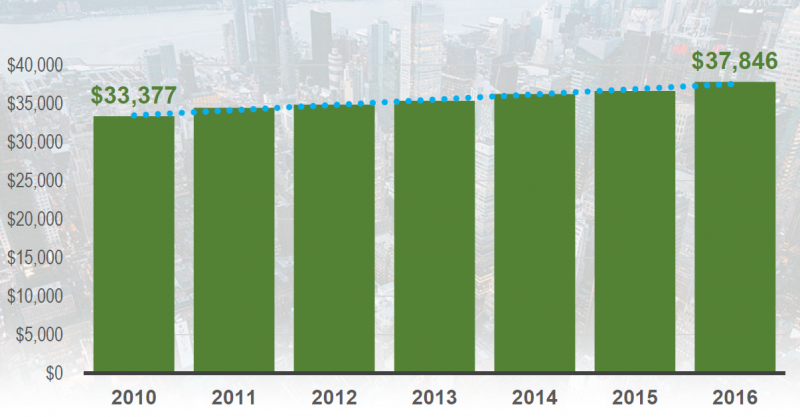
If the gender wage gap were eliminated, meaning that the median full-time working Latina had earnings equal to the median full-time working white man, Latinas working full-time in New York City would earn roughly $38,000 more per year. As it stands, over a 40-year career, the median full-time employed Latina loses more than $1.5 million in earnings due to the gender wage gap, on top of foregone retirement savings, investments, and benefits. Given that women are more likely than men to take time away from the workforce to provide care for children, aging parents, or ill family members, this likely understates the extent of the earnings differentials over a lifetime.
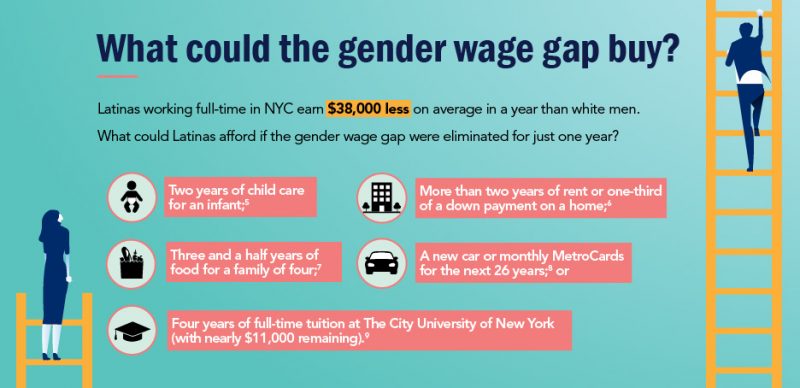
Two years of child care for an infant;[5]
More than two years of rent or one-third of a down payment on a home;[6]
Three and a half years of food for a family of four;[7]
A new car or monthly MetroCards for the next 26 years;[8] or
Four years of full-time tuition at The City University of New York (with nearly $11,000 remaining).[9]
These losses are deeply felt at an individual and family level, undermining the financial security and wellbeing of Latinas across the five boroughs. But the wage gap also limits economic activity in the city. If the gender wage gap were closed, the more than 300,000 Latinas working full-time, year-round in New York City would have collectively contributed nearly $11.8 billion more in earnings to the local economy.
Comparing the median earnings of women of different racial and ethnic groups to those of white men underscores that women are not all similarly situated when it comes to the gender wage gap. Although women across race earn less on average than white men, the disparities are much larger for Latinas. Indeed, the wage gap for Latinas is nearly three times the size of the gap for white women, who make 82 cents for every dollar paid to white, non-Hispanic men. Moreover, the gender wage gap for white women, while still substantial, has closed slightly over the last several years, decreasing from 19 cents in 2010 to 18 cents in 2016. Currently, Latinas make just 60 cents for every dollar paid to white women. In addition, more than half (53.4 percent) of working Latinas make less than $25,000, which is about the annual salary of someone working full-time at the minimum wage, compared to one-third (33.7 percent) of all non-Hispanic working women.[10]
As Chart 2 shows, Latinas’ median earnings are slightly higher than those of their male counterparts, the only group of women for whom that is the case. In 2016, the median earnings of full-time employed Latino men were $36,133, making the racial wage gap between Latino men and white men roughly the same size as the gender wage gap between Latina women and white men. The fact that Latinas’ median earnings are much closer to Latino men than to white women’s further points to the role of race and anti-Latinx racism in perpetuating economic disparities.[11]
Chart 2: Median Earnings for Full-Time Work in New York City (2016)
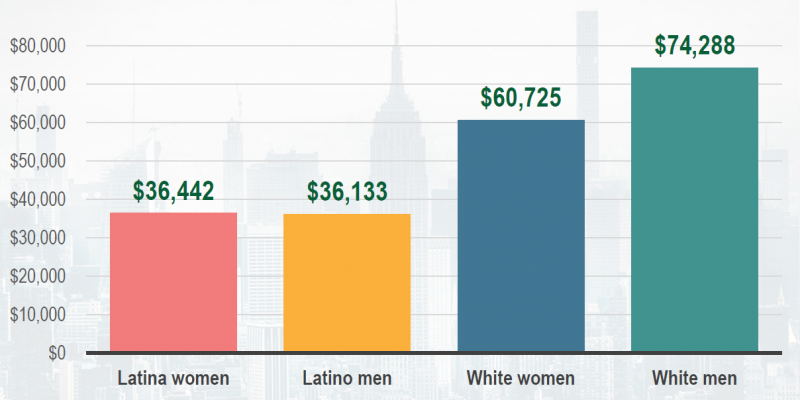
The Comptroller’s analysis found that the gender wage gap in New York City is more pronounced than at the state and national level, where Latinas experience a wage gap of 44 cents and 46 cents, respectively (Chart 3).[12] As with the wage gap for other women of color in the city, this is explained largely by the high earnings of white men in New York City relative to the state and national averages (Chart 4).
Chart 3: Gender Wage Gap for Latinas in New York City is Higher than State and National Averages
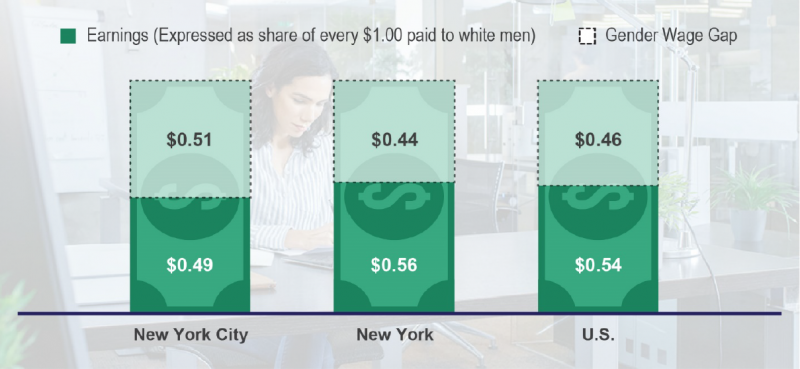
“Latina Equal Pay Day”—the symbolic day that Latinas’ earnings catch up to what white, non-Hispanic men made during the previous calendar year—is observed nationally on November 1st, 2018.[13] However, given that the gender wage gap is larger for Latinas across the five boroughs, in New York City, Latinas will not catch up to what white men made until January 16th, 2019. In other words, Latinas have to work more than two years to make what white men make in a single year. Were the current gender wage gap to hold over a 40-year career, the typical Latina would have to work an additional 42 years—likely into her hundreds—to attain the same earnings as her white male counterpart.
Chart 4: Median Earnings of Latinas & White Men for Full-Time, Year-Round Work (2016)
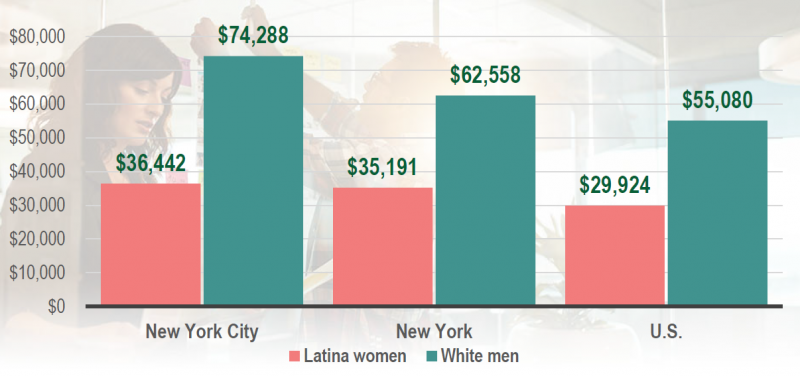
Lifetime losses perpetuated by the gender wage gap may be particularly acute for Latinas, who comprise the majority of female-headed households with children in New York City. Latinas account for 40.5 percent of female-headed households with children; white women, in contrast, head 13.6 percent of these households. In addition, 62.8 percent of Latina-headed households include multiple generations, the highest of all groups, and more than twice the proportion among white women (28.9 percent). Latinas therefore face a disproportionate share of care responsibilities in the city, uncompensated labor that is likely to impact their ability to consistently maintain paid employment over the course of their careers. Latinx households are the poorest in the city, with median household income of roughly $41,500.
Occupational Segregation
One key reason that that the gender wage gap exists is that Latinas are underrepresented in higher-paying occupations, such as finance, law, and engineering, and overrepresented in lower-paying occupations, including service and sales. While more than half (55.9 percent) of white men in New York City work in the category of management, businesses, science, and arts occupations, only one in four (26.4 percent) Latinas do.
As Chart 5 shows, 38.4 percent of all Latinas work in service occupations, such as in restaurants, salons, child care centers, and in private homes—jobs that tend to offer not only lower wages but also less flexibility and more limited benefits than the other occupational groups. While women of color are disproportionately concentrated in such fields, Latinas are especially so. Although Latinas make up one in four (25.7%) women in the labor force, they are fewer than one in six (15.1%) women in management, business, science, and arts occupations, and more than one in three (36.6%) women in service occupations.[14]
Chart 5: Proportion of Latinas & White Men by Occupation (2016)
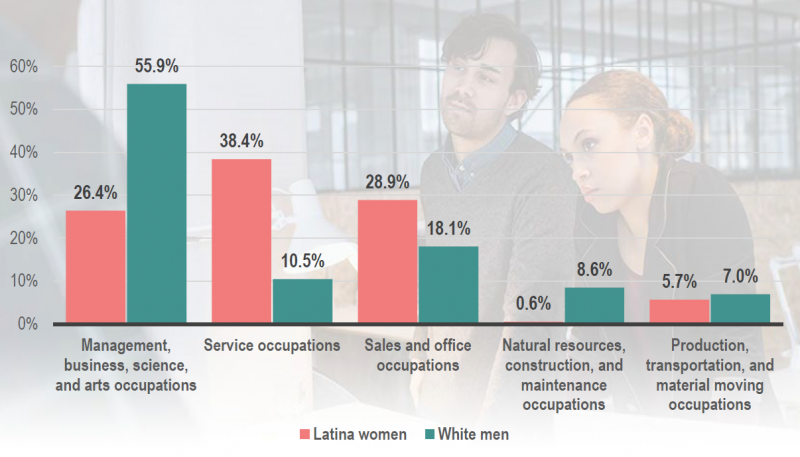
Although Latinas’ lack of representation in higher-paying industries plays a significant role in maintaining the gender wage gap in New York City, it is important to note that Latinas experience pay disparities in these more lucrative fields as well. A Comptroller’s Office report from April 2018 showed that Latinas make less on average than white men even within the same occupational title, and that the disparities tend to grow as average pay within a field rises. For instance, Latina financial managers make roughly $100,000 annually compared to $225,000 for white men, or 45 cents for every dollar paid to white male financial managers, the highest-paying job title included in the analysis with average annual earnings of $166,000. On the other end of the income scale, Latina secretaries make 88 cents for every dollar paid to white male secretaries, a job title with average annual earnings of roughly $56,000.[15] Closing the wage gap, then, will not only necessitate more Latinas entering higher-wage professions. Once there, as in all fields, Latinas must also have equal access to more senior positions and opportunities for earnings growth.
Educational Attainment
Like occupation, differences in educational attainment contribute to the wage disparities between Latinas and other groups in New York City. While less than half (41.1 percent) of all Latinas over 25 have completed at least some college, more than two-thirds (74.7 percent) of white, non-Hispanic men have. Almost four times as many white men as Latinas have a bachelor’s degree or higher, and Latinas remain overrepresented among New Yorkers who have not completed high school.
In New York City as across the country, Latinas and white men have, on average, different access to and opportunities for quality education. Despite this uneven playing field, more Latinas are earning college degrees now than in 2010, and the proportion of Latinas with bachelor’s and advanced degrees is growing faster than most other groups. As Chart 6 illustrates, between 2010 and 2016, the proportion of Latinas over 25 with a bachelor’s degree or higher increased 13.9 percent, compared to 9.0 percent among white, non-Hispanic men and 10.9 percent among all women. While access to higher education should on average lead to better earnings and job prospects, existing research on gender and racial/ethnic wage gaps shows that disparities often remain even among women and men with comparable education. Indeed, a recent Economic Policy Institute analysis found that Latinas earn less on average than white, non-Hispanic men at every educational level, with Latinas with advanced degrees earning less than college-educated white men without advanced degrees.[16]
Chart 6: Percent Change in Proportion of New Yorkers with Bachelor’s or Advanced Degree, 2010-2016

Labor Force Participation and Unemployment
In New York City, more than half (55.5 percent) of Latinas over 16-years-old are in the labor force.[17] While their labor force participation rate has increased slightly since 2010, it remains below white women (60.5 percent), Latino men (70.2 percent), and white men (71.8 percent). Latinas also experience higher rates of unemployment. As Chart 7 shows, in 2016, the unemployment rate among Latinas was 11.2 percent, about twice the rate among both white women (5.2 percent) and white men (5.6 percent).
Chart 7: Unemployment Rate
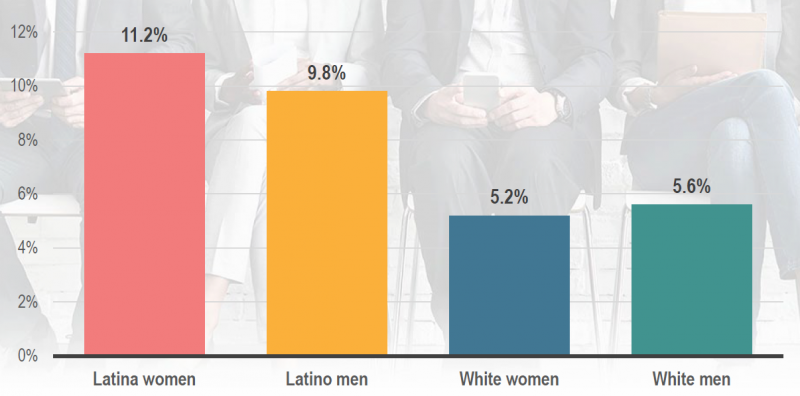
The Comptroller’s Office additionally found that more Latinas work part-time, or fewer than 35 hours per week, than all other groups, including white women—29.2 percent compared to 22.3 percent (Chart 8).[18] That is double the proportion of employed Latino men (14.3 percent) and white men (13.0 percent) working part-time. Part-time employment may be involuntary for some Latinas, due to the unavailability of full-time work as well as the demands of caring for family members, particularly for those with limited access to paid sick and family leave. According to a 2014 national poll, three in four Latinx people reported that they would work more hours if they had the opportunity, the highest proportion across race/ethnicity.[19]
Chart 8: Proportion of Employees Working Part-Time by Gender and Race/Ethnicity
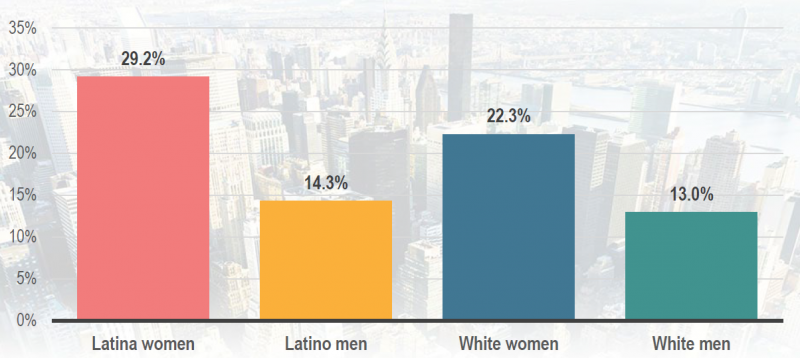
Poverty and Inequality
In addition to experiencing the largest gender and racial/ethnic wage gap, Latinas are also more likely than men and women across racial and ethnic groups to live below the federal poverty level, which is currently around $25,000 a year for a family of four.[20] As Chart 9 shows, in 2016, 29.5 percent of Latinas in New York City had income below the poverty level, more than three times the poverty rate among white men (9.8 percent). This percentage represents a slight increase from 2010, when the poverty rate among Latinas was 28.1 percent. Throughout the period, the poverty rate remained highest in the Bronx, where more than one in three Latinas live in poverty.
Chart 9: Poverty Rate
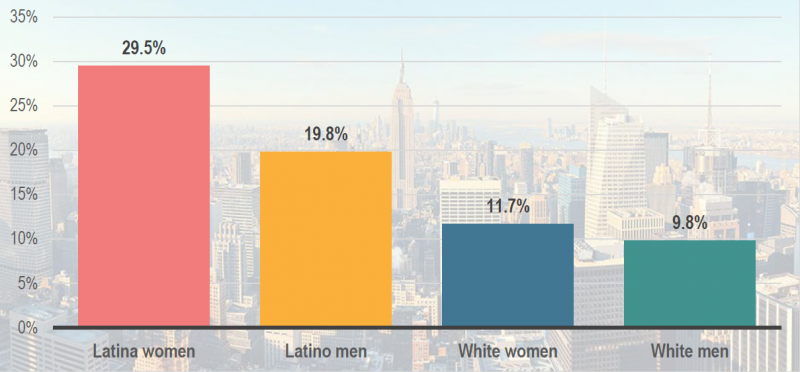
Further analysis of U.S. Census data shows that one in five (19.6 percent) employed Latinas who are heads of households are in poverty, compared to 8.1 percent of all non-Hispanic working women who are heads of households.[21] That a far larger proportion of Latinas than Latino men in New York City live in poverty likely reflects at least in part the underemployment of Latinas relative to their male counterparts and the higher labor force participation of Latino men.
Causes and Impacts of Economic Disparities
The causes of the economic disparities observed among Latinas in New York City are many and interconnected. Structural barriers, including uneven access to quality education and child care, inflexible hours, inadequate accommodations for pregnant and nursing mothers, and exclusionary hiring and performance evaluation processes, all contribute to women remaining in lower-paying positions, if not getting pushed out of the formal workforce altogether. There is evidence to suggest that this may be especially true for Latinas. Nationally, for example, Latinas are the least likely among women across race and ethnicity to use paid leave before or after giving birth and most likely to be subsequently let go from their jobs.[22] Given the high proportion of Latina-headed households with children in the city, structural barriers to motherhood in the workplace likely contribute to their lower earnings relative to other groups of women.
Latinas are also disproportionally concentrated in low-wage industries in which they are likely to be more vulnerable to exploitative practices, including wage theft and other contract violations, which suppress annual earnings. In fact, a representative survey of low-wage employees in New York City showed that laundry services, domestic work, and beauty and nail salons, all professions in which Latinas are overrepresented, are the top three sources of minimum-wage violations in the city.[23]
Importantly, however, vulnerability to such abuse tends to be compounded by immigration status, regardless of industry. The same analysis found that while women are more likely than men to experience minimum-wage violations, the risk is heightened for women not born in the U.S. While more than one in four (27.3 percent) Latinx workers had experienced minimum wage violations, only 3.2 percent of white workers had, and foreign-born Latinx workers experienced the highest minimum wage violation rates of any racial or ethnic group.[24] Survey results from Chicago, New York City, and Los Angeles further reveal that Latina workers have a far higher violation rate than Latino men, 40 percent compared to 24 percent, with foreign-born women more likely to experience violations than foreign-born men.[25] Although higher education appears to provide some protection against such violations, it is no guarantee.
Fear of retaliation likely prevents many Latinas, in particular those who are undocumented, from coming forward to report suspected wage violations, harassment, discrimination, or, even, ask for raises.[26] Although the survey data highlighted above predate a number of policy developments at the city and state level designed to improve conditions in lower-wage industries, enforcement is a consistent challenge. Moreover, recent reporting has illustrated the harm that anti-immigrant discrimination, and specifically the anti-Latin American discrimination espoused by the current federal administration, has done in silencing Latinx communities.[27] The pathways, both perceived and actual, that are available to immigrant Latinas to discuss wage disparities are then further limited by their gender identity, sexual orientation, disability, religion, if they are monolingual non-English speakers, and other factors.
While differences in occupation and education likely account for a significant portion of the wage disparities observed in New York City, existing research confirms that a gender wage gap remains in their absence. Even controlling for occupation, as the Comptroller’s April 2018 analysis did for instance, reveals gaps for Latinas as large as 55 cents on the dollar.[28] Indeed, the model that economists Francine D. Blau and Lawrence M. Kahn developed to disaggregate the causes of the gender wage gap in the U.S. concluded that 38 percent of the gap in women’s and men’s earnings cannot be explained by observable differences such as work experience. Rather, it must be attributed to “unexplained factors.”[29] Such factors might include different styles of negotiating, as well as unconscious bias and overt discrimination against Latinas.
Although there is no precise way to measure how much gender- and race-based discrimination contributes to economic insecurities among Latinas in New York City, institutionalized sexism and racism have undoubtedly reinforced and reproduced them over time. The fact that nearly one in three Latinas in New York City live below the poverty level is, in part, a consequence of the little social and literal value that has been afforded to Latinas’ work. And the collateral harms have been widespread and long-lasting, compromising Latinas’ spending power and their ability to accumulate wealth over time. The effects compound over women’s lifetimes and across generations, impacting women’s capacity to pay down debt, build retirement savings, contribute to their children’s education, and access the kinds of opportunities that all New Yorkers hope to provide for themselves and their families.
The gender wage gap not only impacts Latinas’ economic security but also their physical health and safety. The precariousness associated with living close to or below the poverty level limits Latinas’ access to adequate, regular health care, and the stress resulting from living with inadequate resources can itself cause poor health outcomes.[30] A substantial body of research has established the link between economic insecurity and domestic and gender-based violence. For the purposes of this brief, what remains important to underscore is that eliminating the gender wage gap would have a positive effect on a range of social and health outcomes associated with economic insecurity. Given that Latinas are overrepresented among all women-headed households with children, these benefits would extend to thousands of children in the city.
Realizing Economic Justice for all Latinas
This analysis of the latest U.S. Census data shows that, despite vast contributions to the city, Latinas face striking, persistent disparities in earnings and other indicators of economic well-being, including the highest gender wage gap among women and the highest rate of poverty among all adult New Yorkers. Policy developments in recent years, including increases in the minimum wage, the implementation of paid sick and family leave, and establishment of the Domestic Workers’ Bill of Rights, are significant steps in the right direction, but the Comptroller’s analysis—and Latinas’ lived experiences—make clear that additional solutions are needed.
What would an economic justice policy agenda inclusive of Latinas look like? The four overarching recommendations below offer a starting point, but it will take proactive, thoughtful work between government, employers, educators, and community leaders to begin to address the structural racism and sexism underlying existing disparities. Moreover, Latinas are racially and ethnically diverse. Central American, Mexican, and Dominican women, for instance, face some of the largest wage gaps among women.[31] Failing, then, to account for intragroup differences and tailor interventions to the needs of particular communities is likely to reproduce the same exclusionary practices that have perpetuated inequalities between Latinas and non-Hispanic women.
To help address these inequities and close existing pay gaps, the Comptroller’s Office makes the following recommendations:
- Guarantee family-sustaining wages: Although the minimum wage will reach $15 per hour in New York City by the end of 2018, Latinas are concentrated in jobs in which the minimum wage is too often the ceiling, rather than the floor. The City and State should promote additional strategies to raise wages, strengthen protections, and address the devaluing of jobs in which Latinas have historically been and continue to be overrepresented. This includes supporting existing campaigns to increase and enhance the Earned Income Tax Credit and to boost the wages of New York City’s early childhood educators, the majority of whom are women.[32] It also includes increasing access to and protecting the collective bargaining process, as existing research shows that the gender wage gap narrows for women in unions.[33]
- Expand and create equitable access to affordable child care and paid leave: Greater access to resources like child care as well as paid time off to care for loved ones would help Latinas remain connected to the workforce and advance in their careers. Strategies to achieve this include expanding access to subsidized child care, including for women who work nights and weekends, hours typical of service-sector jobs. And while most private employers in New York City are now required to provide earned paid sick days and paid family leave to their employees, improvements can be made. For example, a private right of action for paid sick leave would enhance enforcement. In addition, paid parental leave should be extended to all municipal workers, tens of thousands of whom, overwhelmingly women of color, still lack access to leave following the birth or adoption of a child.
- Advance educational and occupational equity: In order to address educational and occupational segregation, policies and programs should be adopted that support access to higher education, increase recruitment in higher-paying occupations, and raise the visibility of Latinas in leadership. New York City’s Tech Talent Pipeline and the State’s “If You Can See It, You Can Be It” initiative offer different models of public-private partnerships designed to achieve these aims. Additional resources should be invested in such efforts, with an emphasis on programming informed by and targeted directly to young girls of color. The City should also examine strategies to direct more capital to Latina entrepreneurs and to sustain Latina-owned businesses. As the Comptroller’s Office has recommended elsewhere, a Chief Diversity Officer position should be created within the mayor’s cabinet to deepen the City’s commitment to this work, including expanding its utilization of Minority and Women-owned Business Enterprises (M/WBEs).[34]
- Strengthen enforcement of anti-discrimination laws and labor practices: Despite the fact that New York City has among the strongest anti-discrimination laws in the country, discrimination clearly persists. That is why oversight and enforcement of current statutes must be vigilant. This includes not only holding those in violation accountable but also raising awareness among impacted communities about existing rights and means of seeking recourse. It is imperative that the City foster an environment where all Latinas have the means to safely come forward to share their experiences of discrimination. It also means using the City’s legislative and regulatory powers to create greater transparency around compensation and promote the use of standardized pay rates.
Endnotes
[1] New York City Comptroller Scott M. Stringer, Power and the Gender Wage Gap: How Pay Disparities Differ by Race and Occupation in New York City (April 10, 2018), https://comptroller.nyc.gov/newsroom/on-equal-pay-day-comptroller-stringer-releases-first-of-its-kind-analysis-spotlighting-massive-gender-and-racial-wage-gaps-by-occupation-in-new-york-city/.
[2] U.S. Census Bureau data cited in this brief are derived from the Comptroller’s Office’s analysis of American Community Survey 5-Year Estimates. Unless specified otherwise, data cited as current are 2016.
[3] Institute for Women’s Policy Research, The Gender Wage Gap by Occupation 2017 and by Race and Ethnicity (April 2018), https://iwpr.org/wp-content/uploads/2018/04/C467_2018-Occupational-Wage-Gap.pdf.
[4] New York City Administrative Citywide Services, New York City Government Workforce Profile Reports, Fiscal Years 2013-2016, http://www.nyc.gov/html/dcas/html/workforce_reports/workforce_reports.shtml.
[5] New York State Office of Children and Family Services, “Local Commissioners Memorandum” (September 6, 2016), http://ocfs.ny.gov/main/policies/external/OCFS_2016/LCMs/16-OCFS-LCM-18.pdf.
[6] The NYU Furman Center, CoreData.nyc; The estimate of the cost of a down payment assumes a 20 percent down payment on a home at the median sales price in New York City (see pg. 14 of The NYU Furman Center and Citi, NYU Furman Center/Citi Report on Homeownership & Opportunity in New York City (August 2016), http://furmancenter.org/files/NYUFurmanCenterCiti_HomeownershipOpportunityNYC_AUG2016.pdf.
[7] Estimate based on the cost of a “low-cost” food plan (second most expensive plan), as defined by the U.S. Department of Agriculture, inflated by 28 percent to account for higher grocery prices in New York City. Cost does not include food eaten away from home. See the Comptroller’s Office’s Affordability Index: https://comptroller.nyc.gov/reports/affordability-index/.
[8] MTA, “Fares & MetroCard,” http://web.mta.info/metrocard/mcgtreng.htm; Car price estimate based on Kelley Blue Book average July 2018 transaction prices, https://mediaroom.kbb.com/2018-08-01-Demand-Quickly-Backing-Away-from-Cars-Pushing-Average-New-Car-Transaction-Prices-Up-for-July-2018-According-to-Kelley-Blue-Book.
[9] The City University of New York, “Tuition & Fees,” (accessed July 3, 2018), http://www2.cuny.edu/financial-aid/tuition-and-college-costs/tuition-fees/.
[10] New York City Comptroller’s Office analysis of U.S. Census Bureau, American Community Survey 2016 5-Year Estimates using IPUMS-USA, University of Minnesota, www.ipums.org.
[11] Latinx, used throughout this brief, is a gender-neutral term for people of Latin American descent.
[12] The gender wage gap for Latinas as reported at the national level may differ slightly depending on the U.S. Census Bureau survey used. Based on Current Population Survey data released in September 2017, for example, the earnings ratio between Latinas and white, non-Hispanic men is 53 percent (or 53 cents on the dollar). This is slightly lower than the figure cited here, which is derived from American Community Survey 5-Year Estimates, of which 2016 is the latest year available.
[13] See https://www.latinaequalpay.org/ for more on the nationwide observance of Latina Equal Pay Day.
[14] New York City Comptroller’s Office analysis of U.S. Census Bureau, American Community Survey 2016 5-Year Estimates using IPUMS-USA, University of Minnesota, www.ipums.org.
[15] New York City Comptroller Scott M. Stringer, Power and the Gender Wage Gap: How Pay Disparities Differ by Race and Occupation in New York City (April 10, 2018), https://comptroller.nyc.gov/newsroom/on-equal-pay-day-comptroller-stringer-releases-first-of-its-kind-analysis-spotlighting-massive-gender-and-racial-wage-gaps-by-occupation-in-new-york-city/.
[16] Elise Gould and Adriana Kugler, “Latina workers have to work 10 months into 2017 to be paid the same as white non-Hispanic men in 2016,” Economic Policy Institute (November 2017), https://www.epi.org/blog/latina-workers-have-to-work-10-months-into-2017-to-be-paid-the-same-as-white-non-hispanic-men-in-2016/.
[17] The labor force is defined here as the proportion of the total 16 and older population that is employed or unemployed. The unemployment rate is the proportion of the civilian labor force that is unemployed. The American Community Survey (ACS) and Current Population Survey (CPS) collect labor force data differently, utilizing different questionnaires and reference periods. As a result, ACS figures and those produced and reported by the Bureau of Labor Statistics, which inputs CPS data, may vary.
[18] New York City Comptroller’s Office analysis of U.S. Census Bureau, American Community Survey 2016 5-Year Estimates using IPUMS-USA, University of Minnesota, www.ipums.org.
[19] Economic Policy Institute, Irregular Work Scheduling and Its Consequences, Briefing Paper #394 (April 9, 2015), https://www.epi.org/files/pdf/82524.pdf.
[20] U.S. Department of Health and Human Services, “Poverty Guidelines for 2018,” https://aspe.hhs.gov/poverty-guidelines.
[21] New York City Comptroller’s Office analysis of U.S. Census Bureau, American Community Survey 2016 5-Year Estimates using IPUMS-USA, University of Minnesota, www.ipums.org.
[22] Lynda Laughlin, Maternity Leave and Employment Patterns: 2006-2008, Current Population Report, P70-128, U.S. Census Bureau (2011), https://www.census.gov/prod/2011pubs/p70-128.pdf.
[23] Annette Bernhardt, Diana Polson, and James DeFilippis, Working Without Laws: A Survey of Employment and Labor law Violations in New York City (2010), https://s27147.pcdn.co/wp-content/uploads/2015/03/WorkingWithoutLawsNYC.pdf.
[24] Annette Bernhardt, Diana Polson, and James DeFilippis, Working Without Laws: A Survey of Employment and Labor law Violations in New York City (2010), https://s27147.pcdn.co/wp-content/uploads/2015/03/WorkingWithoutLawsNYC.pdf.
[25] Annette Bernhardt et al., Broken Laws, Unprotected Workers: Violations of Employment and Labor Laws in America’s Cities (2009), https://www.nelp.org/wp-content/uploads/2015/03/BrokenLawsReport2009.pdf.
[26] Annette Bernhardt, Diana Polson, and James DeFilippis, Working Without Laws: A Survey of Employment and Labor law Violations in New York City (2010), https://s27147.pcdn.co/wp-content/uploads/2015/03/WorkingWithoutLawsNYC.pdf.
[27] The Guardian, “Fearing deportation, undocumented immigrants wary of reporting crimes” (March 23, 2017), https://www.theguardian.com/us-news/2017/mar/23/undocumented-immigrants-wary-report-crimes-deportation.
[28] New York City Comptroller Scott M. Stringer, Power and the Gender Wage Gap: How Pay Disparities Differ by Race and Occupation in New York City (April 10, 2018), https://comptroller.nyc.gov/newsroom/on-equal-pay-day-comptroller-stringer-releases-first-of-its-kind-analysis-spotlighting-massive-gender-and-racial-wage-gaps-by-occupation-in-new-york-city/.
[29] Francine D. Blau and Lawrence M. Kahn, The Gender Wage Gap: Extent, Trends, and Explanations, Journal of Economic Literature (2017), https://pubs.aeaweb.org/doi/pdf/10.1257/jel.20160995.
[30] New York City Department of Health and Mental Hygiene, Health Disparities in New York City (April 2010), https://www1.nyc.gov/assets/doh/downloads/pdf/episrv/disparitiesone.pdf.
[31] National Women’s Law Center, Equal Pay for Latinas (November 2017), https://nwlc.org/resources/equal-pay-for-latinas-2017/.
[32] The Comptroller’s Office’s Earned Income Tax Credit proposal is accessible at https://comptroller.nyc.gov/reports/fighting-poverty-and-expanding-opportunity-the-earned-income-tax-credit-in-nyc/.
[33] Elise Gould and Celine McNicholas, “Unions help narrow the gender wage gap,” Economic Policy Institute (April 2017), https://www.epi.org/blog/unions-help-narrow-the-gender-wage-gap/.
[34] New York City Comptroller Scott M. Stringer, A New Charter to Confront New Challenges (September 2018), https://comptroller.nyc.gov/wp-content/uploads/documents/A-New-Charter-to-Confront-New-Challenges.pdf.